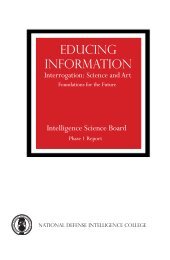COURTING A RELUCTANT ALLY - National Intelligence University
COURTING A RELUCTANT ALLY - National Intelligence University
COURTING A RELUCTANT ALLY - National Intelligence University
- No tags were found...
Create successful ePaper yourself
Turn your PDF publications into a flip-book with our unique Google optimized e-Paper software.
involved, is a good indicator that information from other sources was beingshared as well. 291The U.S. naval mission to England was placed under RADM Ghormley’scharge and the new U.S. naval attaché, CAPT Charles P. Lockwood, assumedduties as both the attaché and as Ghormley’s Chief of Staff. 292 This staff, whichwould form the nucleus of what would later become the Commander, NavalForces Europe Staff, contained significantly more naval observers than had beenin England in the past and, to avoid tensions, “great emphasis was placed on pickingofficers who would be discreet and cooperative in working with the British.”293 The flow of information from the British, established by the BaileyCommittee, continued to flourish and material that was previously held closelywas now open to the Americans, given that the British now had formal agreementsand the Lend-Lease program to assuage their doubts about U.S. cooperation.294 Processing this increased amount of technical and intelligenceinformation became an issue, however, and a division of labor was establishedwhereby the “Naval Attaché served as the channel for supplying intelligence ofenemy organization, operations, and plans....Operational intelligence becameincreasingly a function of the staff of the Special Naval Observer [Ghormley].” 295One of the most tangible benefits of the exchanges once the U.S. mission wasestablished was in the area of imagery intelligence (IMINT). Ghormley wasgranted permission to have an officer observe British aerial photographic reconnaissanceand imagery interpretation operations. The officer assigned to this task,Lieutenant Commander Robert S. Quackenbush, was highly impressed with Britishcapabilities in this area and his efforts led to the establishment of the first U.S.imagery interpreter school in September 1941. 296 While this cooperation inIMINT was significant, the start of U.S.-UK SIGINT cooperation can also betraced to this period, although this major achievement was overshadowed by the291 Hinsley, British Intel vol. 2, 55. Hinsley states that, when the JSM JIC was stood up, the commonperspective of the British was that, “Washington...had little to offer, and...closer contacts withthe United States intelligence organizations left the British authorities in no doubt that it would havelittle to offer for many months.” This was not an entirely fair assessment, given the U.S. successagainst the Japanese Purple code and the generally superior state of U.S. intelligence on Japan, butit does give insight into the British mindset at the time, which was chauvinistic and completelyfocused on the European situation. For additional information see Hinsley, British Intel, vol. 1, 314.292 Bath, 56.293 COMNAVEU Administrative History, 11, 14; Alan Goodrich Kirk, CAPT, USN, Director ofNaval <strong>Intelligence</strong>, Letter to Rear Admiral Walter S. Anderson, USN, 27 March 1941, Kirk Papers.294 2 Bath, 56.295 COMNAVEU Administrative History, 108. There would be 103 assistant U.S. naval attachésin England by September 1941. For additional information see COMNAVEU Administrative History,34.296 Packard, 179-180; Dorwart, Conflict of Duty, 154-155.81
















